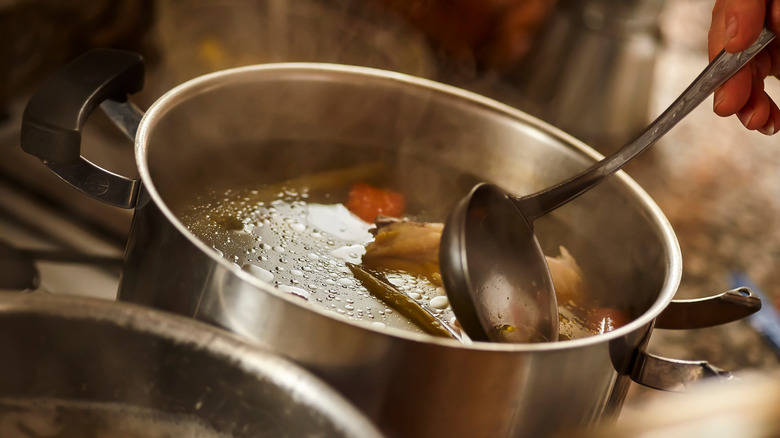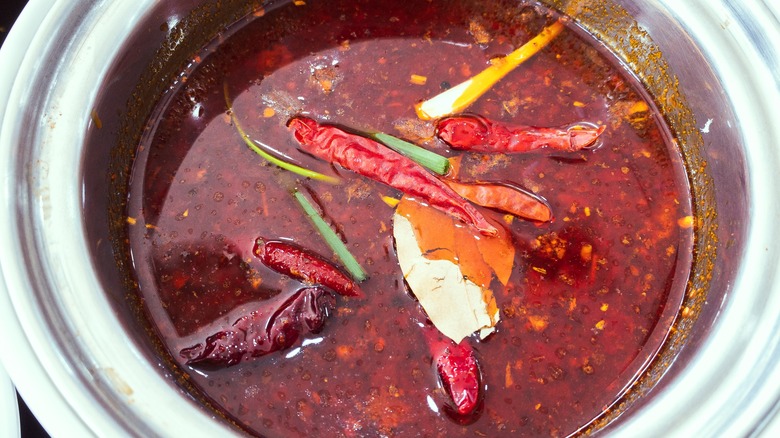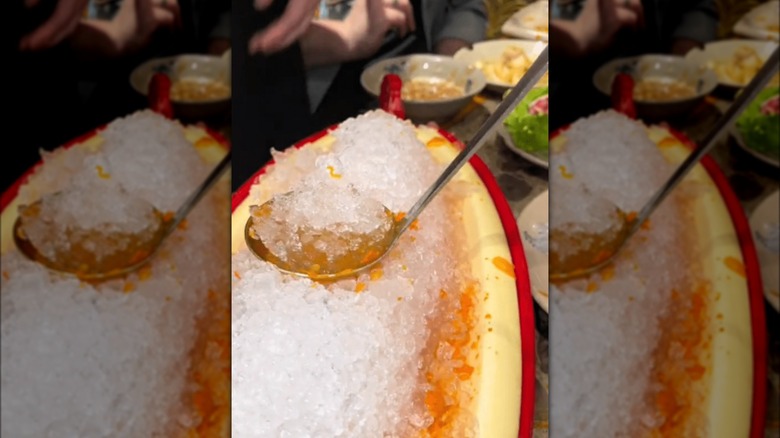The Genius Ice Hack To Remove Excess Oil From Soups And Sauces
There's a very common sight that anyone who makes homemade soups or sauces is bound to see sooner or later: Bubbles of oil floating on top of the simmering liquid. Whether it's from the cooking oil that most recipes will require you to add for flavor, aroma, and a silkier soup texture; or the fat from meaty ingredients being released during the cooking process, a bit of fat is often unavoidable.
The keyword here is "a bit" — too much of it, and the dish would turn out greasy and unappetizing. Here's a clever trick to remove that excess oil in seconds: Use an ice-filled ladle! As you run a chilled, ice-filled ladle over the top of the liquid, the cold temperature causes the fat to solidify and cling to the back of the utensil, making it easy to scoop out and discard. This handy technique isn't just for home cooks — it's also a favorite in hotpot restaurants to keep their soup bases light and flavorful. So the next time you're cooking and find yourself without a skimmer, keep this nifty trick in mind!
The secret lies in how fat and oil reacts to the cold
The secret lies in how fats and oils behave when exposed to cold temperatures. Every type of fat and oil has a specific temperature at which it transitions from a liquid to a solid state. When you fill a metal ladle with ice, it chills down to a temperature that's low enough to cause most common cooking fats and oils to solidify almost instantly. As you glide this ice-cold ladle over the surface of your simmering dish, the fat molecules that come into contact with the chilled metal rapidly freeze and cling to the back of the ladle.
This process effectively separates the unwanted oil from the rest of the liquid, creating a thin "shell" of solidified fat on the ladle's surface. With a simple swipe of a paper towel, you can easily remove this solidified oil, leaving behind a far less greasy and more enjoyable dish.
A few tricks and tips to keep in mind
To make the most of this ice hack, consider pre-chilling your ladle in the freezer for a few minutes before use. This simple step eliminates the need to wait for the ladle to cool down after scooping up ice, making the process more convenient.
When filling the ladle, opt for small, crushed ice cubes instead of large chunks. The crushed ice will distribute more evenly within the ladle, creating a larger chilled surface area for the fat to cling onto. This ensures that the ladle is cooled uniformly and will work more effectively as a fat skimmer. You should also prep a bowl of crushed ice nearby and dip the ladle inside after a few passes in the hot soup. This will keep the ladle from warming up and the stuck fat globules from melting too quickly.
As you glide the chilled ladle across the surface of your soup or sauce, focus on gently brushing the bottom side of the ladle against the top layer where all the excess oil accumulates (don't dip the ladle too far so that the soup actually leaks into the ladle). After each pass, carefully wipe the solidified fat off the ladle with a paper towel before continuing. With just a bit of practice, you'll even be able to pry off the entire solidified "crust" of fat as a single piece — super satisfying!


